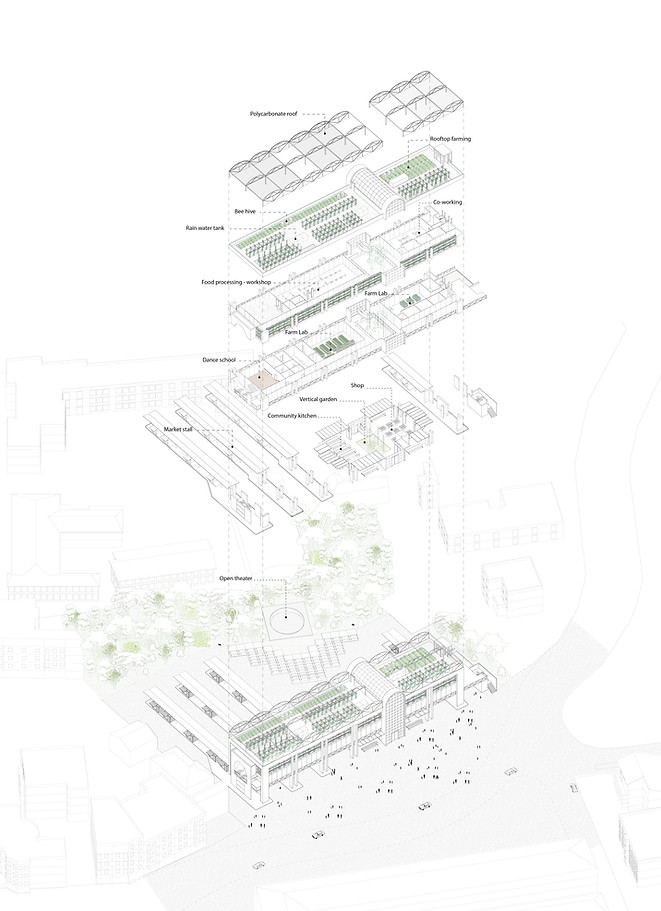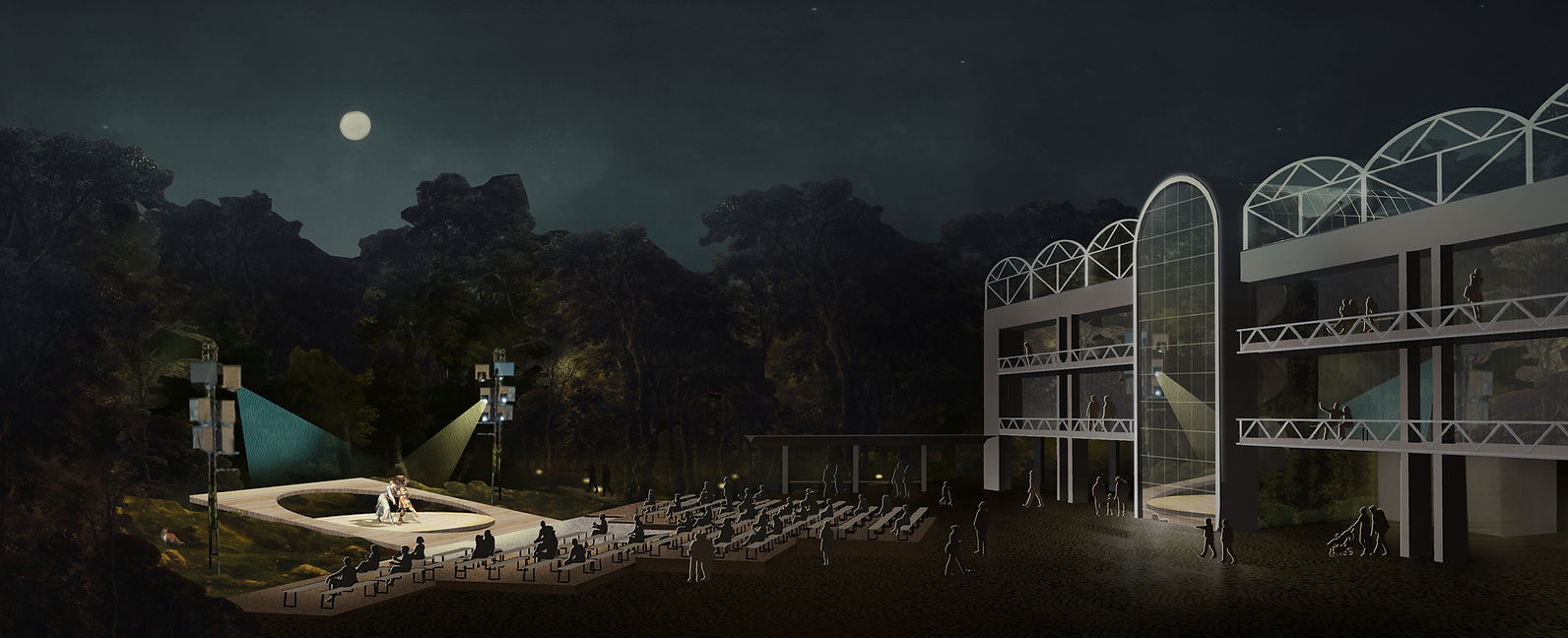
Agroecological Condenser
Winner Europan 16 / Living Cities - San Dona Venezia
Terminologies:
1. The term agroecology was in parallel proposed by German zoologists (Friederichs, 1930),
and American crop physiologists (Hanson, 1939) as a synonym for the application of ecology
within agriculture. Agroecology is the study of the interactions between plants, animals,
humans, and the environment within agricultural systems. Agroecology is a holistic approach
that seeks to reconcile agriculture and local communities with natural processes for the
common benefit of nature and livelihoods.
The box symbolizes the window of agroecology within food production systems. The viewpoints of the different schools of
ecology are marked with eye signatures. The classical, scientifific disciplines, where some are within the window of agroecology,
are lined up in the right column, ordered in a hierarchy with the ‘hard’ disciplines at the bottom and the ‘soft’ disciplines at the
top (Checkland, 1999)
2.
Social condenser: In the OMA book Content, a social condenser is described as a
"Programmatic layering upon vacant terrain to encourage dynamic coexistence of activities
and to generate through their interference, unprecedented events."
Reinvent the city’s center
The cities have always been the spiritual reflection of time. In ancient times, the city’s center was
configured to carry political, cultural ideologies and foundational democracy which are fundamental
aspects defining the society. In modern times, our culture, civilization, and built environment are facing
another challenge on a global scale which is climate change and the degradation of nature. Hence,
beyond creating solely a space for commercial, communal activities, restoring the urban ecology
system in the city’s center is a defining feature that promotes nature-centric urbanization, and
harmonious cohabitation between humans, nature, and other species.
The relocation of the bus station presents an opportunity to reclaim the city’s center as a living and dynamic system that
favors and stimulates socio-cultural networks of all kinds. As a philosopher, Clément Rosset said
”anti-nature is nature anti, a way of defining a thing by its natural opposite: the city posited as the
opposite of nature. The city, hence, would be anti-artificial; it must then recover and once again
find life, nature, animals, greenery, purity, calmness”.
San Dona is a middle-sized city defined by a mono-centric structure: the core city is dominated by a
transport hub which is surrounded by a semi-ring peri-urban system including the residential and
industrial fabric. On its edges is the ring of peri-urban agricultural areas. At the urban scale, the
project aims to investigate an alternative way of configuring the city by integrating the agroecological
system into the existing urban fabric. By reversing the conventional structure and introducing again to
the city’s center the notion of productivity and living features through an acupuncture network of
small-scale agricultural gardens, and micro forests. Furthermore, the urban agroecologicalapplication
is critical to limit cities’ impact on climate change, mitigates and reduces ecological
degradation, increases the resilience and productivity of the city center. The station would be the
starting point of the whole urban renewal process and the nexus of historical, cultural, educational,
creative, and natural concentration.
The Corso Urbano as a Living system
In the modern West, the image of continuous circulation within the
organism has been used to describe the living since 1682, when
William Harvey discovered the continuous circulation of blood
within the human body: its continuity guarantees life.
Inspired by this idea, the concept of the project at the urban scale
eventually is conceived as a linear continuous ecological system
organized around the Corso Urbano. This urban backbone is
characterized by a green canopy connecting the Piave riverside,
the Victoria bridge up to new Porta Nuova, and a complex network of
pocket gardens and micro forest. This whole agroecosystem
engenders a continuous flux of exchanges across the city.
It eventually turns the city into a system of cohabitation between
different living forms, promoting the interactions between plants,
animals, humans, and the environment within agricultural systems.
The project seeks to reconcile agriculture and local communities
with natural processes for the common benefit of nature and
livelihoods.
The Covid-19 has reminded us that We are not the only creatures on
this planet. Sharing the living
space and cohabitating with other species, making the built
environment adapting to the wildlife is the
best way to make the city more resilient and equal.
The Piave river corridor as the starting point of an urban ecological journey
The Piave River corridor is currently under-used and cut off from the rest of the city. The project
proposes to open up this boundary, erase the urban fragmentation, and bridge the two separated
parts of the city. By leading people, from the city to the riverside, the project aims to re-establish the
dialogue between the city center and its river. The actual large empty park will become a place for
experimental permaculture and wildlife habitat.
A system of elevated wooden structure integrates subtly into the agricultural park, in between the
existing vegetation will provide better accessibility to the river. Beyond the function as a recreational
space, the restoration of the ecosystem will provide habitat for a diversity of species and bring
back wildlife into the city. The agricultural park also participates in the food supply chain of the city.
Recreational and educational activities will also be introduced in total harmony with nature.
At the entrance of the city, The social parking silos will be installed. It not only increases the capacity
of the parking lot by greater density and compactness but also provides a social gathering place by
the riverside. The wooden structure helps the building to be blended and camouflaged into the
wooded area.
Pocket garden and micro forest network as the agroecosystem.
Pocket garden
At the regional scale, according to the study, products from Veneto can reach southern Italy in 10
hours; Frankfurt or Sicily in 15 hours; Berlin, Brussels, or Paris in 17 hours. Based on this relatively
short transportation time, there is a great potential to make the Veneto “ The Garden of Europe” (Bello
2004). Furthermore, San Dona was largely occupied by the marshes, residues of the great lake of
Piave until the 19 th century. The land is characterized by a large network of waterways which is
beneficial for agricultural activities. And due to the abundance of water, it is the perfect habitat for
animal species, insects, amphibians, and small mammals; the city eventually has no doubt the most
favorable conditions to develop a tactical agroecosystem.A French landscape architect, Gilles Clément
argued that all of the underused parcels of land where man does not use, hosting rich biodiversity
compared to the monocultural fields, are sprayed with phytosanitary products.
We thus look at waste/ underused land. By identifying them and turning them into potential
productive spaces. An acupuncture network of pocket gardens and the micro-urban forest will
be formed and interwoven into the existing urban fabric. In order to cope with the given architectural
programs and urban conditions, the landscape will acquire various programs that support the growth
of the neighborhood and form different functional clusters.
The pocket garden network envisions a city that produces its own necessities. It also supports
recreational, educational activities, and functions as a social condenser encouraging dynamic
exchanges, social interaction, and coexistence through common unexpected events.
Micro Forest.
A city can’t be resilient and reclaim its status as a living system only with the simple plantation of trees
and flowers. Forests in urban settings, which are non-traditional objects by definition, are gaining
increasing significance in the urban context. Forests with their specific microclimate can contribute to
developing ecosystems within the urban space. The visible feature of the forest is its structure, as it
consists of several layers with slightly unique ecological conditions, corresponding to different
organisms living there.
The network of micro forests should initiate the return of the natural environment to the city, the
wildest and the most primeval one - at the same time creating recreational space for urban residents
as well as educational opportunities for future challenges. A network of micro forests is thus identified
strategically between the edges of different urban fabrics. A functional biodiversity system integrates
the city in the regional ecological process.
The Janus-faced station. The binary nature and culture, recent past and
future.
Italo Calvino wrote about the city “is a place of exchange, these exchanges are not just trade in
goods, they also involve words, desires, and memories.” San Dona's center has been defined by the
ATVO station as a symbolic anchor of the city, a place of exchange. Being placed in the critical
transitional period, The question is how to carry its memory of the past and transcend to the future
while taking into consideration the local and global challenges of our time.
Janus frequently symbolized change and transitions such as the progress of past to future as he could
see into the past with one face and into the future with the other. The old ATVO station is situated on
the hinge of not only the spatial transition from the historical to peri-urban fabric but also the transition
of time.
The repurposing of the ATVO station hence presides over all beginnings, the passage, and
transitions. The building’s configuration and position allow it to interact with two different premises. We
try to conceptualize the new programs of the station following the Janus-faced metaphor principle.
The front façade opens to the front piazza which represents the extroverted dynamic space with
diverse flexible functions that transform in time dimensions. It could host diverse public events,
commercial activities but also be part of the main traffic circulation. This urban void in the heart of the
city will provide extension spaces for public activities. In parallel, the backyard of the station isenclosed
by a micro forest which functions not only as a productive space but also creates an
inward-looking atmosphere forming a theatrical atmosphere. Passing through the station as a
transitional space from one side to another, the urban sequences will be shifted from an extroverted,
dynamic space to an introverted space. One can experience walking through the piazza to a hidden
campo which is an experimental space promoting the binary cultural and natural. This duality could
be a focal point, a magnet for the whole city and region.
The station itself is functioning as a process of production, transformation, storage, and distribution.
By cutting the intermediates, it establishes a short circuit of production and consumption of local
agricultural products. The productive roof has the form of arcs to continue one of the features of the
building and give it an iconic dimension.
The stone pavement runs throughout the building from the interior to the exterior without any spatial
limitation. The ground floor of the station is no longer an obstacle but a means of connection. With
flexible architectural elements, the place can serve a diverse set of programs and possibilities of uses
from a community kitchen to a series of commercial shops promoting local agricultural and artisanal
products. On regular days throughout the week, market stalls selling fresh fish and local agricultural
products are constructed. During the year, stalls selling second-hand books, clothes, and repair
workshops may appear. For special festivals, a wooden stage is built in the backyard. Community
kitchen opens, trestle tables and benches laid out. For a week, children’s games, music concerts take
place. The city’s center reclaims its initial function as a social space.
Beyond merely an obsession with the green revolution, agroecological condenser seeks to
comprehend how the binary of agricultural and ecological approaches contribute to the creation of
social spaces and the living environment of San Dona di Piave.




















